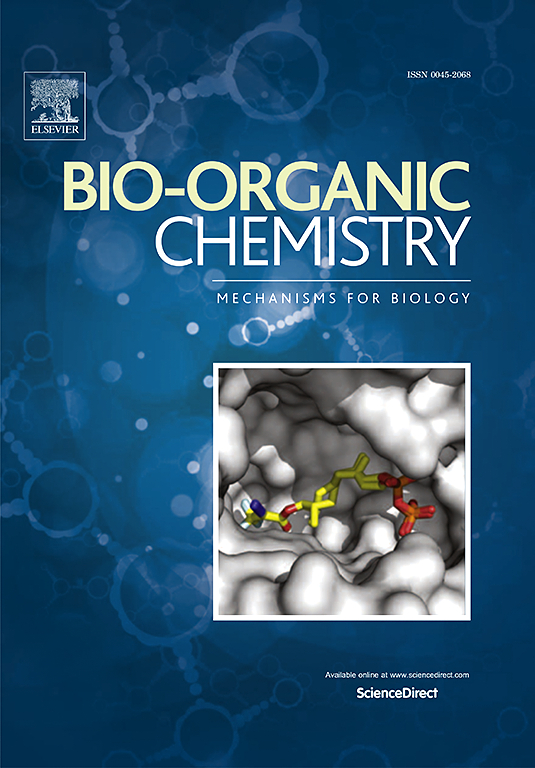选择性雌激素受体调节剂的精确结构操纵导致了一流的噻吩-3-苯酰胺衍生物作为潜在的内质酰胺拮抗剂而没有子宫萎缩活性
IF 4.5
2区 医学
Q1 BIOCHEMISTRY & MOLECULAR BIOLOGY
引用次数: 0
摘要
本研究介绍了两组化合物:A组,其中包括噻吩-3-苯甲酰胺,B组,其中包括吡唑-4-苯甲酰胺。我们设计了这些化合物,以雌激素受体(ER)为目标,同时最大限度地减少子宫萎缩活动。这两个面板的化学结构来源于选择性雌激素调节剂甲基哌啶吡唑(MPP)的结构修饰。这些改良旨在减少子宫萎缩效应。在我们的设计中,我们在三个苯基环之间加入了酰胺、胺和酮间隔剂,取代了靶内质网拮抗剂中的中心噻吩和吡唑环。这种结构策略旨在改变三对酚代谢物的形成,这与这类化合物的潜在雌激素活性有关。A组化合物的细胞毒性显示出对雌激素依赖性乳腺癌细胞MCF7细胞的显著活性。重要的是,这些化合物对其他细胞系的细胞毒性很小,包括皮肤、骨肉瘤和三阴性乳腺癌。其中,5-苯甲酰-噻吩-3-carboxamide 5a和5-(4-氯苯甲酰)-噻吩-3-carboxamide 5d对MCF7细胞的细胞毒性最强,IC50值分别为7.38 μM和8.50 μM。此外,5a和5d均显示出潜在的抗雌激素作用,在未成熟大鼠子宫组织中无雌激素活性。在剂量效应实验中,5d抗雌激素效价(EC50 = 5.530 μM)与他莫昔芬(EC50 = 7.625 μM)相当。分子对接和分子动力学模拟表明5d具有抗雌激素活性,而5-氟苯甲酰对应物5e无活性。活性部位的非活性衍生物5e表现出不利的构象和不稳定的药物受体复合物形成。本文章由计算机程序翻译,如有差异,请以英文原文为准。

Precise structure manipulation of selective estrogen receptor modulators led to first-in-class thiophene-3-benzamide derivatives as potential ER-antagonists without uterotrophic activity
The present study introduces two sets of compounds: panel A, which features thiophene-3-benzamide, and panel B, which includes pyrazole-4-benzamide. We designed these compounds to target estrogen receptors (ER) while minimizing uterotrophic activities. The chemical structures of the two panels have been derived from structural modifications of the selective estrogen modulator, methyl-piperidinopyrazole (MPP). These modifications aim to reduce uterotrophic effects. In our design, we incorporated amide, amine, and ketone spacers between the three phenyl rings, substituting the central thiophene and pyrazole rings in the target ER antagonists. This structural strategy aims to alter the formation of tris-p-phenol metabolites, which are associated with the potential estrogenic activity of this class of compounds. The cytotoxicity of the compounds from panel A revealed significant activity against MCF7 cells, which are estrogen-dependent breast cancer cells. Importantly, these compounds demonstrated minimal cytotoxicity against other cell lines, including skin, osteosarcoma, and triple-negative breast cancer. Among the compounds tested, 5-benzoyl-thiophene-3-carboxamide 5a and 5-(4-chlorobenzoyl)-thiophene-3-carboxamide 5d exhibited the highest cytotoxicity against MCF7 cells, with IC50 values of 7.38 μM and 8.50 μM, respectively. Furthermore, both 5a and 5d showed potential as antiestrogens, exhibiting no estrogenic activity in the uterine tissues of immature rats. In the dose-response experiment, the 5d antiestrogenic potency (EC50 = 5.530 μM) was comparable to that of Tamoxifen (EC50 = 7.625 μM). Molecular Docking and Molecular Dynamics simulations elucidated the antiestrogenic activity of 5d and inactivity of 5-fluorobenzoyl counterpart, 5e. The inactive derivative 5e in the active site exhibited an unfavorable conformation and unstable drug-receptor complex formation.
求助全文
通过发布文献求助,成功后即可免费获取论文全文。
去求助
来源期刊

Bioorganic Chemistry
生物-生化与分子生物学
CiteScore
9.70
自引率
3.90%
发文量
679
审稿时长
31 days
期刊介绍:
Bioorganic Chemistry publishes research that addresses biological questions at the molecular level, using organic chemistry and principles of physical organic chemistry. The scope of the journal covers a range of topics at the organic chemistry-biology interface, including: enzyme catalysis, biotransformation and enzyme inhibition; nucleic acids chemistry; medicinal chemistry; natural product chemistry, natural product synthesis and natural product biosynthesis; antimicrobial agents; lipid and peptide chemistry; biophysical chemistry; biological probes; bio-orthogonal chemistry and biomimetic chemistry.
For manuscripts dealing with synthetic bioactive compounds, the Journal requires that the molecular target of the compounds described must be known, and must be demonstrated experimentally in the manuscript. For studies involving natural products, if the molecular target is unknown, some data beyond simple cell-based toxicity studies to provide insight into the mechanism of action is required. Studies supported by molecular docking are welcome, but must be supported by experimental data. The Journal does not consider manuscripts that are purely theoretical or computational in nature.
The Journal publishes regular articles, short communications and reviews. Reviews are normally invited by Editors or Editorial Board members. Authors of unsolicited reviews should first contact an Editor or Editorial Board member to determine whether the proposed article is within the scope of the Journal.
 求助内容:
求助内容: 应助结果提醒方式:
应助结果提醒方式:


